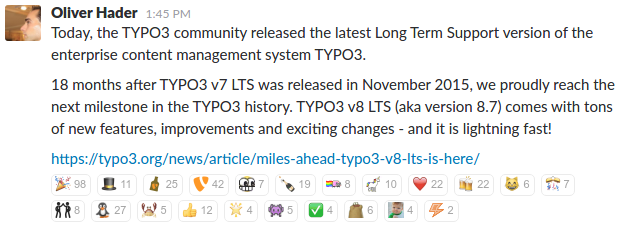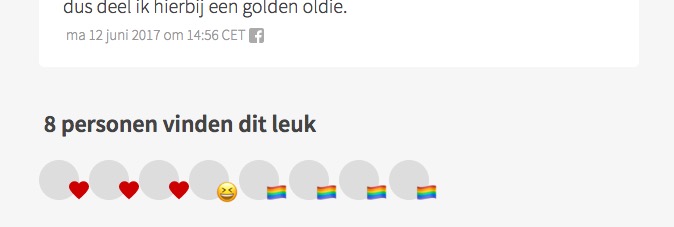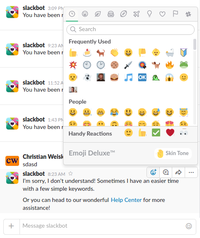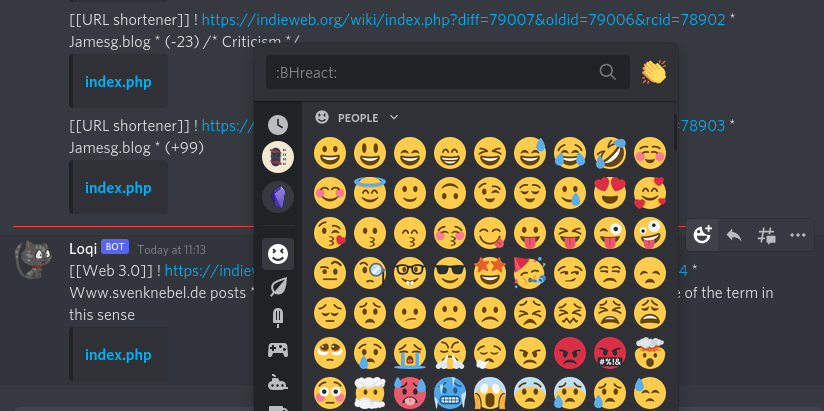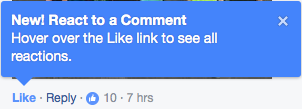reacjis
This article is a stub. You can help the IndieWeb wiki by expanding it.
reacjis are a collection of reacji posts displayed on a web page, usually after an article, reply, or other piece of content on a website. reacjis may be accompanied by a count of reacjis.
For example:
The row(s) of buttons with icons at the bottom indicate the reacji that the post has received, with the numbers inside them showing the counts of how many of each reacji has been received.
For individual reacji posts and guidance on how to markup a reacji permalink, see:
Why
Why should you support receiving reacjis and displaying them?
So people can send you reacjis and have it show up!
E.g. a 🎂 for your birthday, or different kinds of reactions instead of just a "like".
How to
How to receive and display reacjis
You can detect a reacji reply post by inspecting any incoming reply to see if it is a single emoji character. This is harder than it seems as there are many possible emoji sets and some emoji can consist of multiple characters combined. Just looking for the single character emoji will cover most emoji however.
- Be sure to remove whitespace as there may be some extra at the beginning or end unintentionally
- brid.gy backfeeds twitter replies with the @username at the front, you may want to strip this
- You may want to strip HTML tags to make sure they don't prevent you recognizing an emoji
Once you have detected the reacji and what emoji it is, display it as a reaction like you display likes, followed by the count next to it or stamped on it like in the Slack example above.
IndieWeb Examples
Examples of receiving and displaying reacjis:
Ben Roberts
![]() Ben Roberts displays reacji in Postly since 2015-12-08 (his birthday, send him a 🎂) https://ben.thatmustbe.me/note/2015/12/8/2/
Ben Roberts displays reacji in Postly since 2015-12-08 (his birthday, send him a 🎂) https://ben.thatmustbe.me/note/2015/12/8/2/
Sebastiaan Andeweg
 Sebastiaan Andeweg displays received reacjis in a facepile since 2017-03-12.
Sebastiaan Andeweg displays received reacjis in a facepile since 2017-03-12.
Reacji displayed as a facepile under a post on Seblog.nl. (Actual faces removed for the screenshot, grey rounds contain photo's from Facebook.)
Previous Examples
Greg V
unrelentingtech was displaying reacjis since 2016-03-21 (shown as plain comment replies as of 2022-01-14)
Silo Examples
Besides Slack, individuals have started to post reacjis on other silos.
Slack
Discord
Discord allows you to post reacjis on any message.
Here is how Discord displays a reacji on a message:
To add a reacji to a post, one must click the "Add reaction" button that appears when you hover over a message. Then, one can select a reactji to post on a message.
Here is the reacji selection interface on Discord:
Facebook has reacji (Path-style, as a small set of emoji-like graphics) as an extension of "Like" and calls them reactions. Supported since 2016-02-24 on posts, and since 2017-05-03 on comments. emoji and text (on hover) equivalents:
- 👍 like
- ❤️ love
- 🌸 (purple) flower - temporary Time 2016, The Verge 2017
- 🌈 rainbow (flag) - temporary Telegraph 2017, NBC 2017
- 😆 haha
- 😮 wow
- 😢 sad
- 😠 angry
Articles:
- https://newsroom.fb.com/news/2016/02/reactions-now-available-globally/
- some concept/design background information
Examples:
- https://www.facebook.com/tantek.celik/posts/10102142524051423 (requires login)
2017-05-03 New feature prompt to "React to a Comment":
GitHub
GitHub also supports a small set of reacji in response to pull requests, issues, and comments (and calls them reactions), since 2016-03-10:
- 👍 +1
- 👎 -1
- 😆 Laugh
- 🎉 Hooray
- 😕 Confused
- ❤️ Heart
- 🚀 Rocket
- 👀 Eyes
You can POSSE these to GitHub using Bridgy Publish.
More:
- https://help.github.com/articles/about-conversations-on-github/#reacting-to-ideas-in-comments (screenshot in that page shows a crying emoji but doesn't appear to be currently supported)
Path
Path has had limited reacji, as a small set of emoji-like graphics, since (??? their launch) years ago, and was likely the first silo to do so.
(need screenshot)
Basecamp
Basecamp replaces their previous “like” functionality with “boosts” which aim to merge reacji with short text reactions and avoids counts. They also only show the boosts to the author, not to others. [This article https://m.signalvnoise.com/introducing-boosts-an-all-new-way-to-show-your-support-in-basecamp-fae325634998] should probably be analyzed more and summarized best practices and indieweb relevant pieces entered in here.
(Need screenshot)
Implementations
Libraries
"single emoji" detection:
 Ben Roberts made a PHP library for determining if a string is a "single emoji" (a harder problem than it seems) available at https://github.com/dissolve/single-emoji-recognizer (selfdogfooding on his own site)
Ben Roberts made a PHP library for determining if a string is a "single emoji" (a harder problem than it seems) available at https://github.com/dissolve/single-emoji-recognizer (selfdogfooding on his own site) Tantek Çelik wrote a ~25 line PHP function with a heuristic for determining if a string is a "single emoji" - simpler yet more approximate, catches common cases, likely to handle future emoji expansions too:
Tantek Çelik wrote a ~25 line PHP function with a heuristic for determining if a string is a "single emoji" - simpler yet more approximate, catches common cases, likely to handle future emoji expansions too: function is_one_emoji($s)in https://github.com/tantek/cassis/blob/master/cassis-lab.php (selfdogfooding on his own site)
Facebook reactions to reacji:
Services
Brainstorming
...
History
Slack reacji
Slack was first to ship a built-in reacji feature that allows anyone to respond to any Slack message with a single emoji, which are then tallied like votes.

